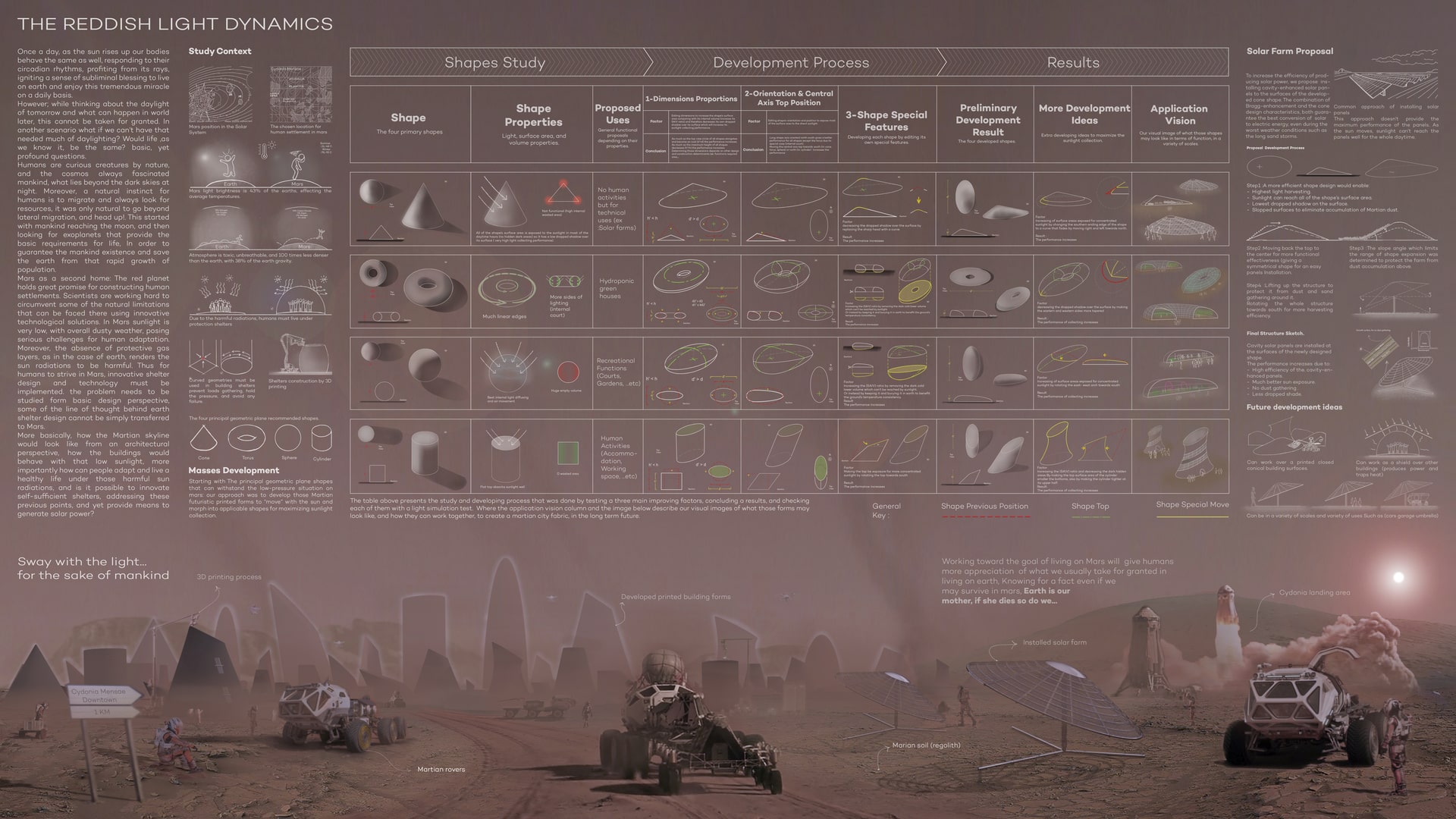Project Description
Starting with the slogan of “daylight of tomorrow”, our idea is based on a futuristic vision where humans migrate to Mars as a second home. Despite the high potential for human settlement on Mars , there is plenty of work required to overcome some of the planet’s challenges for humans adaption. For example, Mars has low levels of sunlight, and it is generally dustier and ruddier than earth. Moreover, the sun radiation is harmful for humans, causing health and adaption problems. Producing solar power is also challenging due to these previous points. The project aims to shape Martian building masses to maximize the collected sunlight to provide the best daylighting opportunities. Additionally, those new forms aid in warming the internal spaces and reduce the consumption of energy. Study context: To aid in this forming criteria, a depth study was performed for the sun movement, angles, and brightness on Mars. Moreover, the climatic and geographic conditions of Cydonia region in the north polar basin, which is the recommended location for human settlement in mars, was thoroughly investigated: • Sun brightness is 43% of the earths, with distinct red color coming partially from scattering due to dust. • The solar mapping that we draw shows a southern angle with an average of (80summer-30winter), moving daily from east to west. • The day-night cycle is 24H,37min, with daylight approximately being 12H per day, (close to earth conditions). • Effected by sunlight, temperatures in Cydonia range between (-21,-50)C and decrease to less than -80C in winter nights. • Atmosphere is toxic, unbreathable, and very thin (1% of the earths pressure), with gravity of 38% of the earth’s gravity. • Sandstorms are very common situation. Surviving on mars requires a long list of determinants, in this project the architectural perspective is investigated. Building shelters on mars must be done with 100% local materials, existing in abundant amounts in the landing site. The building techniques involve 3D printers and Robots, without humans help. Printing process must be implemented during the whole construction process, even for the openings and windows which are unlockable and should be printed cumulatively with the whole building. Printers should be supplied with power, and since resources are very limited in Mars, and the nuclear power is dangerous, Solar energy must be used. The highlighted problem of limited sunlight complicates energy production, threatening life there since energy production is vital for almost all activities. Scope of work: • Massing development: Mars’ atmospheric pressure is very low, building shelters on mars would be limited on using curved geometries. Building will then be capable to hold pressure and prevent any failure due to differences between internal and external pressure. We studied four primary pressure-withstanding shapes: (cone-torus-sphere-cylinder). Simultaneously, we determined the light harvesting behavior of each one. We used computer aided simulations where the surface area illuminated by light is integrated to probe the light harvesting behavior as the sun angle changes. Based on light, area, and volume properties, a general functional usage was determined for each of those shapes. Secondly, by using the same test, we used optimization steps for four proposed shapes, in order to minimize their own dropped shadow and maximize the sunlight harvesting performance. Finally, we investigated specialized surfaces for further improvement, then we introduced our vision for future applications for each shape. • Printing materials: The project is conceptually general, it is not confined to specific time nor to a specific material. It presents a comprehensive outlook vision where daylight is the main and real building design material. The buildings can be realized at any time with any building materials available in mars (ex: Regolith-Silica-Ice-…etc). • solar farm proposal: Our proposal is to use the developed cone shape, in combination with resonantly enhanced surface for efficient conversion of solar to electric energy, even during the worst weather conditions like long sandstorms. The cone shape, optimized slope angle, and cavity enhanced solar cells over its surface would simultaneously protect the panels from dust gathering and enable collecting higher amount of energy. All of these developed parameters aid in achieving the goals motivated above. This comprehensive design criteria highlighted here is flexible and can be generalized to different structure sizes, materials, and building applications. Working toward the goal of living on Mars gives us more appreciation of what we usually take for granted in living on earth, made us think about spending some effort trying to save our home planet, and prioritize daylight as our main forming material even here on earth. Hoping for a healthy future, where the buildings of the Mother Earth and the red planet are both designed to move with the sun, reduce polluted power usage, and extract as much as possible of the sun, in lighting and energy aspects.
